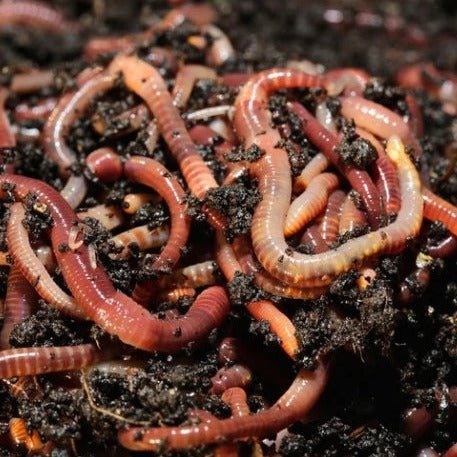Discover Where to Buy Red Wigglers for Your Next Composting Project
Wiki Article
The Ultimate Overview to Taking Care Of Red Wigglers in Your Garden
Caring for red wigglers in your yard is a crucial element of lasting composting techniques that can significantly improve dirt health and wellness and fertility. Recognizing their certain habitat demands, dietary preferences, and upkeep demands is vital for cultivating a productive vermicomposting atmosphere.Recognizing Red Wigglers

Red wigglers are characterized by their reddish-brown pigmentation and fractional bodies, which can grow up to 4 inches in size. They have a high reproductive price, creating cocoons which contain multiple embryos, considerably increasing their population in suitable environments. Where to buy red wigglers. Their physiology enables them to tolerate numerous moisture degrees, although they thrive in moist problems, ideally between 60 ° F and 80 ° F.))

Establishing Up the Habitat
Creating an ideal environment for red wigglers is crucial for optimizing their composting effectiveness and general wellness. Red wigglers flourish in a damp, dark setting with a temperature array of 55 to 77 levels Fahrenheit.When choosing a container, pick one that is well-ventilated to enable for air flow while preventing excess moisture loss. Plastic bins, wooden boxes, or specialized worm bins are all effective options. The bottom of the container ought to have drainage holes to avoid water buildup, which might result in anaerobic conditions damaging to the worms.
Regularly check the dampness degree of the bed linens, and include water as required to keep the optimal wetness. By establishing these conditions, you will certainly create a thriving environment for your red wigglers, encouraging efficient composting and much healthier worm populations.
Choosing the Right Food
Picking the appropriate food for red wigglers is vital for their wellness and composting effectiveness. These worms thrive on a well balanced diet regimen that includes a range of natural products.Red wigglers favor food that is sliced or shredded, as this increases area and advertises more efficient digestion. Additionally, introducing food in tiny amounts stops overfeeding, which can cause anaerobic conditions damaging to worm wellness. Keeping an eye on the worms' eating behaviors can likewise give understandings; if the food is consumed rapidly, consider slowly raising the quantity.

Preserving Dampness and Temperature Level
A well balanced diet plan is only part of the formula when it pertains to guaranteeing the health of red wigglers; keeping appropriate wetness and temperature is equally vital. Red wigglers thrive in a wet setting, preferably in between 70-85 ° F(21-29 ° C) This range sustains their metabolic procedures and enhances their capacity to break down raw material efficiently.Alternatively, extreme dampness can create anaerobic problems, which may damage the worms and create undesirable odors. Consistently checking the dampness web content and readjusting as essential is necessary for a flourishing worm population.
To minimize temperature extremes, think about utilizing insulation for outside bins or transferring the bin to a temperature-controlled or shaded location. By very carefully handling both dampness and temperature level, you produce an optimal atmosphere for red wigglers, boosting their productivity and overall health.
Harvesting Compost and Care Tips
Collecting compost from your red wigglers is a rewarding process that not only advantages your garden yet also enhances the performance of your worm container - Where to buy red wigglers. To begin, choose a harvesting approach that fits your configuration-- whether it's the tray, pyramid, or standard container method. Each technique enables the splitting up of compost from worms efficientlyAs soon as you're ready to harvest, emphasis on timing. Preferably, wait up until the compost is dark, brittle, and earthy-smelling, normally after three to six months of food digestion. To collect, you can delicately excavate the compost from one side of the container, permitting worms to migrate to the uninterrupted side. You can use light to urge worms to tunnel much deeper, making it easier to gather the completed garden compost.
Care pointers after harvesting consist of replenishing your worm bin with fresh bed linens and food scraps to preserve a healthy worm populace. Guarantee that the moisture and temperature levels continue to be ideal, and on a regular basis check for any signs of distress amongst the worms. By complying with these practices, you'll make sure a sustainable cycle of garden compost production that enriches your yard.
Conclusion
In conclusion, the successful care of red wigglers requires a complete understanding of their habitat, dietary needs, and environmental problems. Developing a suitable environment with correct air flow and wetness levels is necessary for fostering their health and wellness and productivity.By developing these conditions, you will certainly develop a growing setting for your red wigglers, encouraging efficient composting and much healthier worm populations.
The pH degree of the food is one more Where to buy red wigglers crucial aspect; red wigglers prosper in a slightly acidic to neutral atmosphere.A balanced diet is only part of the equation when it comes to guaranteeing the health and wellness of red wigglers; maintaining correct wetness and temperature level is equally crucial. By meticulously managing both dampness and temperature level, you produce an optimal environment for red wigglers, boosting their efficiency and total wellness.
Gathering compost from your red wigglers is a satisfying process that not only advantages your yard yet also boosts the effectiveness of your worm container.
Report this wiki page